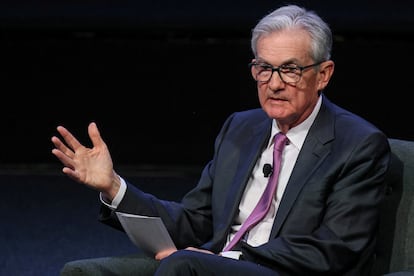Federal Reserve planning to postpone decision on new rate hike to December
Faced with blistering economic growth, the US central bank is expected to keep the price of money stable at the conclusion of its meeting on Wednesday


The U.S. economy grew in the third quarter at the fastest pace since 2021, while job creation accelerated in September. The rise in interest rates has so far failed to cool demand, although everything indicates that growth is slowing down. There are those who believe that in 2024 there is even a risk of recession, although that is forecast that has been failing to come true for more than a year. Faced with a complicated economic landscape, Federal Reserve Chairman Jerome Powell has promised to act cautiously. The market believes this means he will keep interest rates at 5.25%-5.5% at a two-day meeting ending on Wednesday, and that the decision on whether it is necessary to order an additional hike will be left for December 13.
Powell, therefore, will keep the pause button pressed, according to analysts. Current rates are already the highest since 2001, after rising 5.25 points in a year and a half to curb inflation. There is no agreement on whether rates have already reached their ceiling in the current cycle of increases or if there is still some leeway for more hikes. The rise in long-term interest rates has tightened financial conditions and, by Powell’s own admission last month in New York, this may save him the need for further rises to official rates. Furthermore, the economic outlook could become a little more complicated if there is no agreement to avoid a partial government shutdown when a stopgap spending bill expires on November 17.
In any case, given that inflation remains clearly above the price stability objective of 2%, the Fed chief prefers to leave the door open to new rate increases, depending on new emerging data.
Assuming that the Fed will leave things unchanged, Gilles Moëc, chief economist at AXA IM, believes that “attention this week is likely to focus on how Jay Powell will balance his answers to two obvious questions: how does the sustained resistance of U.S. data fit in with the Fed’s current position, and how is the Fed taking into account the current market-driven tightening of financial conditions?”
“The Fed has adopted a more cautious tone, arguing that rate markets have done part of the tightening,” say analysts at BofA Securities. They expect that at the news conference to follow the Monetary Policy Committee meeting, Powell will reiterate that the Federal Reserve is “acting carefully.” They also believe Powell will repeat his argument that further hikes could be warranted if there is “additional evidence” of above-trend growth or of strains in the labor market.
“We continue to expect a further rise in December,” said analysts at BofA Securities, who nevertheless added that “this is a very tight prediction, since the economy could slow down significantly in the fourth quarter for various reasons, such as a slowdown in business investment or from stockpiling, the burden of student loan repayments, financial tightening and a possible government shutdown.”
Powell has been seeking a soft landing for the U.S. economy for more than a year, that is, a cooling of the economy capable of reducing inflation without a full-blown recession. Recession forecasts, including those of the central bank’s own economists, have been wrong again and again. Instead, the economy has accelerated. The pool of savings accumulated during the Covid pandemic, an expansive fiscal policy and strong job creation have boosted consumer spending. Meanwhile, inflation has lost strength, but Powell is aware that the battle is not won and there is still a risk of it becoming entrenched at levels above 3%.
Before the next Federal Reserve meeting on December 12 and 13, employment and inflation data for October and November will be released, along with several other indicators. At the September meeting, the members of the Monetary Policy Committee predicted a further quarter-point rise in official interest rates before the end of the year. If this does not happen in the end, it would not be the first time that they have failed to meet their own forecasts.
Sign up for our weekly newsletter to get more English-language news coverage from EL PAÍS USA Edition
Tu suscripción se está usando en otro dispositivo
¿Quieres añadir otro usuario a tu suscripción?
Si continúas leyendo en este dispositivo, no se podrá leer en el otro.
FlechaTu suscripción se está usando en otro dispositivo y solo puedes acceder a EL PAÍS desde un dispositivo a la vez.
Si quieres compartir tu cuenta, cambia tu suscripción a la modalidad Premium, así podrás añadir otro usuario. Cada uno accederá con su propia cuenta de email, lo que os permitirá personalizar vuestra experiencia en EL PAÍS.
¿Tienes una suscripción de empresa? Accede aquí para contratar más cuentas.
En el caso de no saber quién está usando tu cuenta, te recomendamos cambiar tu contraseña aquí.
Si decides continuar compartiendo tu cuenta, este mensaje se mostrará en tu dispositivo y en el de la otra persona que está usando tu cuenta de forma indefinida, afectando a tu experiencia de lectura. Puedes consultar aquí los términos y condiciones de la suscripción digital.
More information
Archived In
Últimas noticias
Rowan Atkinson tops Netflix at 70: ‘He’s as funny as ever’
Israeli recognition of Somaliland stirs up the Gulf
Tiger Woods turns 50: Will he continue playing on the PGA Tour or take a back seat?
The surreal journey of James Nnaji, the Barcelona youth player selected in the NBA Draft who ended up in the NCAA
Most viewed
- Oona Chaplin: ‘I told James Cameron that I was living in a treehouse and starting a permaculture project with a friend’
- Reinhard Genzel, Nobel laureate in physics: ‘One-minute videos will never give you the truth’
- Sinaloa Cartel war is taking its toll on Los Chapitos
- Why the price of coffee has skyrocketed: from Brazilian plantations to specialty coffee houses
- Chevy Chase, the beloved comedian who was a monster off camera: ‘Not everyone hated him, just the people who’ve worked with him’










































